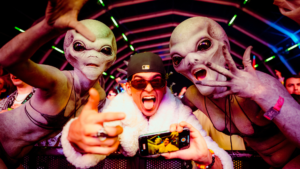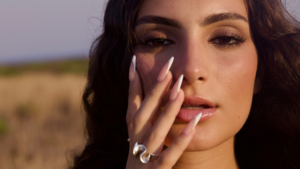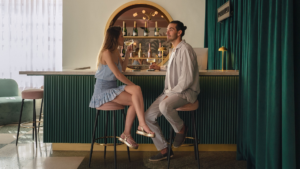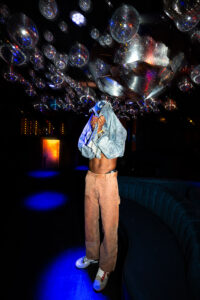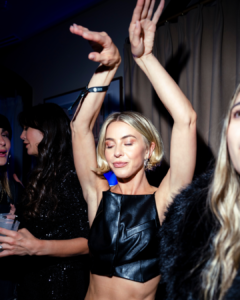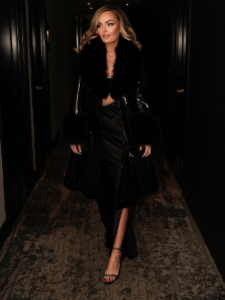When the Economy Crashes, the Dance Floor Booms
- By: Julianne Elise Beffa
TikTok’s recession trends reveal how economic anxiety is fueling a new wave of nightlife, proving that when times get tough, people party harder.
TikTok has a new obsession, and it’s not a beauty hack or a dance challenge. It’s the so-called “recession indicator.” The trend started as a joke but quickly turned into cultural commentary. Instead of flexing new designer bags or five-star brunches, creators are filming the little lifestyle downgrades that quietly mark an economic shift: switching from salon manicures to press-on nails, letting their roots grow out, making coffee at home, skipping Ubers, and proudly posting $5 meal deals from fast-casual spots that suddenly feel like a treat. Restaurants are reviving happy hour specials, bars are offering prix fixe menus, and “girl dinner” has gone from meme to movement. It’s frugality, but make it fashion.
There’s humor in it, but also truth. Consumer confidence in the U.S. recently slid to its lowest level in 12 years, as measured by The Conference Board, whose “forward-looking expectations” index fell to just 65.2, below the 80 threshold often used to signal a recession. Eight in ten Americans report changing their spending habits because of economic uncertainty, 86 percent say they believe the economy is unstable, and 58 percent expect a recession. In other words, the “recession indicator” trend isn’t just an aesthetic, it reflects real anxiety.
And yet, amid all the lifestyle tightening, something unexpected is bubbling beneath the surface: nightlife. Because history proves that every time the world gets rocky, people don’t just stay home, they head out. The Roaring Twenties, famed for their glamor and abandon, didn’t emerge from calm times. They followed a global pandemic, war, and economic tremor. The flapper generation drank gin in speakeasies not because times were easy but because they weren’t. Nightlife has always been about escapism when escapism feels essential.
This generation is channeling that same spirit. The “recession indicator” trend on TikTok doesn’t just catalogue cutbacks, it signals a collective pivot. Everyone’s trying to save money without sacrificing the parts of life that still feel good. And yet amid this new minimalism, something else is happening: nightlife is coming back stronger than you might expect. That’s not a contradiction, it’s a pattern.
In Atlanta, the nightlife economy created $5.1 billion in annual revenue and supported an economic impact of nearly $8.5 billion, including 41,000 jobs. In Dallas, a “night-time economy” study found direct economic impact of $15 billion, and when including induced effects, $24.4 billion, supporting 256,000 jobs. These numbers show that the night out is not just fun, it’s serious business, even when the economy is wobbling.
Why does nightlife persist or even surge during downturns? Part of it is cultural and part psychological. Research on alcohol use during the Great Recession of 2008 to 2009 found that while overall alcohol consumption in the U.S. declined slightly, the prevalence of frequent binge drinking increased from 4.8 percent to 5.1 percent. In other words, people may cut back in some ways but still seek release in others. Similarly, a Nielsen survey found that over 80 percent of consumers said they were spending the same or more on beer, wine or spirits despite economic pressures. The study noted that alcoholic beverages are an affordable luxury. That luxury, framed properly, is what nightlife offers: accessible escapism when other pleasures feel out of reach.
When people can’t afford designer bags, they’ll still buy a ticket to a night that makes them forget why they can’t. Economic downturns fuel a yearning for freedom and relinquishing control, even if temporarily. Nightlife becomes a rebellion against the heaviness of the day.
What’s different this time is the form. The revival isn’t about bottle-service excess but about experience. It’s “affordable luxury.” Smaller clubs, hotel lounges, pop-ups, and immersive experiences are dominating. The economics are shifting: brands lean into after-hours, venues focus on vibe over price tag, and nightlife’s energy changes. They’re designing for emotional impact, not just extravagance. In that way, the “recession indicator” trend and the nightlife resurgence aren’t at odds. They’re two sides of the same coin: people saving in daylight and celebrating at night.
On social media, this is visible in the low-budget “fit check” for a club night, the “pre-game at home because we can’t afford the cover” video, and the hashtagged “still going out even if I have to skip brunch next week.” One Tumblr pastiche described it well: “It’s gallows humor,” said a digital culture expert about the recession indicator memes.
The interplay of real economic indicators and cultural reaction is especially apparent now. The TikTok-lensed phenomenon of “recession indicator” stands alongside serious data: consumer sentiment is tanking, spending patterns are shifting, industries are under strain. Yet at the same time, the night-time economy is showing resilience and potential for revival. What looks like a contradiction is actually balance.
The dressing up, the going out, the sparkle despite the squeeze- these are not signs of denial but of defiance. When life feels uncertain, the night becomes where we reclaim agency, joy, and connection. The more chaotic the day world, the more meaningful the after-hours world becomes.
In a time when everyone’s clutching their wallets, nightlife reminds us that joy is still free, at least for a few hours. So yes, the “recession indicator” trend captures the anxieties of our moment- root regrowth, thrifted manicures, and budget dinners. But it also signals something else: a shift in how we’re choosing to spend what remains of our disposable income. Maybe we’ll skip brunch, but we’ll still dance. Maybe we’ll get press-on nails instead of the salon, but we’ll still go out later. Because when the economy trips, nightlife picks up the beat.
The economy might be crashing, but the party’s just getting started. We’ve been here before. Every downturn in history has had its glittering counter-movement. When the world burns, we dance, not because we’re ignoring reality, but because we’re reclaiming it. Nightlife has always been humanity’s most stylish form of survival, and this generation, roots and all, is proving it once again.
